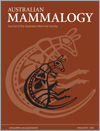
Australian Mammalogy
Volume 42 Number 1 2020
AM18038What can we deduce about the reproductive condition of spinifex hopping mice (Notomys alexis) from external examination?
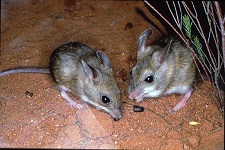
Field studies often use external examination of the vagina or swelling of the scrotum to make deductions about the reproductive condition of rodents. In this study we sought to determine what information on reproductive condition could be gained from external features of spinifex hopping mice (Notomys alexis). Our results indicate vaginal perforation is an acceptable indicator of sexual maturity in females, but scrotal bulge size and scrotal pigmentation is not a reliable indicator of male reproductive condition in N. alexis. Photograph by William Breed.
AM18029Distribution patterns of east Australian humpback whales (Megaptera novaeangliae) in Hervey Bay, Queensland: a historical perspective
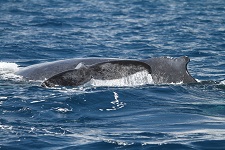
This study serves as a baseline to detect changes in the distribution and residency time of humpback whales in Hervey Bay after swim-with-whale tourism has been implemented. We demonstrate that the distribution of humpback whale mothers with a calf differs in time and space when compared to adult and juvenile whales in Hervey Bay, Australia; an important resting stop for whales on their southern migration. Understanding how humpback whales use Hervey Bay is an important component for the effective management of whale populations and growing tourism in this area. Photograph by J. McCordic/Pacific Whale Foundation.
AM18029 Abstract | AM18029 Full Text | AM18029PDF (356 KB) | AM18029Supplementary Material (708 KB) Open Access Article
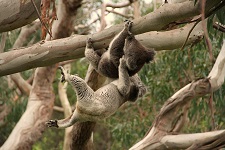
The koala is one of Australia’s most iconic animals; however, we know relatively little about their social interactions. In this study, we examined interactions between 33 wild koalas in a high-density population during the breeding period. Our results suggest that most males defend access to one or two females and that females were unreceptive to most mating attempts. Importantly, our results contrast with those found for a low-density populations of koalas, suggesting that some aspects of koala social structure may be plastic relative to population density. Photograph by Desley Whisson.
AM18036Spatial ecology of the quokka (Setonix brachyurus) in the southern forests of Western Australia: implications for the maintenance, or restoration, of functional metapopulations
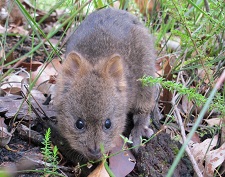
We used radio-telemetry to investigate home range and movements of quokkas in the southern forests of Western Australia. We found that quokkas in this region have larger home ranges (71 ± 5.8 ha) and move larger distances (up to 10 km/night) than in other regions. Quokkas used riparian vegetation to move between habitat patches, but spent only 40% of their time in this habitat. Therefore, protecting riparian vegetation is important for quokkas, but it is unlikely to meet their habitat and spatial requirements. Photograph by Karlene Bain.
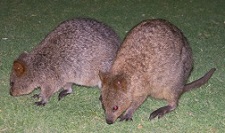
We estimated the home ranges of 22 male and 23 female quokkas in four habitat types on Rottnest Island: coastal dune, grassland, woodland and settlement areas developed for tourism. The mean home range size of quokkas was 1.91 ± 0.23 ha, and quokkas rested outside of the settled areas during the day and travelled back to these areas to feed at night. This research demonstrates how tourism development can impact on the behaviour and movement patterns of local species. Photograph by Catherine Herbert.
AM18032A DNA toolbox for non-invasive genetic studies of sambar deer (Rusa unicolor)
AM18019Relationship between the common brushtail possum (Trichosurus vulpecula) and tuart (Eucalyptus gomphocephala) tree decline in Western Australia
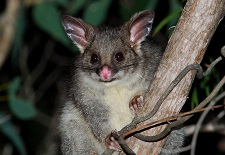
Declines in tree health can cause changes to food and shelter resources which is likely to have substantial consequences for fauna. This study of common brushtail possums in south-west Western Australia found there to be no difference in possum numbers at sites with declining and healthy tuart trees, suggesting possums had adequate shelter and feeding resources available to them. We revealed some interesting interactions between tree health and brushtail possums, but ongoing monitoring would be required to determine the ultimate fate of these populations. Photograph by Dr Leonie Valentine.
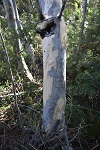
High summer temperatures may influence animals in their choice of shelter sites. This is of particular interest if providing artificial shelters to tree-hollow using species. I found the use of nest boxes by eastern pygmy-possums was not influenced by maximum temperature. On four days when maximum ambient temperatures reached 36–41°C, temperatures inside nest boxes were 3–4°C cooler whereas tree hollows were 5–8°C cooler. It appears pygmy-possums using these nest boxes will not experience heat stress. Photograph of a tree hollow in which temperature was recorded by Ross Goldingay.
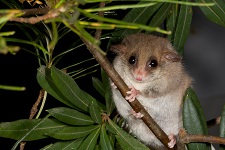
Pygmy-possums are small, cryptic marsupials than finely tune their daily and seasonal activities to their energy requirements. While eastern and western pygmy-possums live in contrasting habitats, the thermal attributes of both species’ nesting sites appeared to be important for maintaining a positive energy balance. Better understanding the nesting requirements of arboreal wildlife will help inform conservation management practices aiming to preserve habitat essential for species survival. Photograph by James M. Turner.
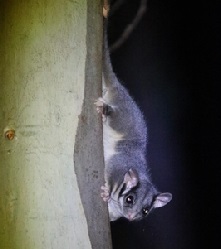
Leadbeater’s possum is considered to be highly specialised, requiring mature, intact forest stands with high densities of old eucalyptus trees containing hollows suitable for nesting. Wildfires can significantly alter forest stand conditions and impact habitat suitability for unknown lengths of time. Our discovery of Leadbeater’s possum colonies 15 km from closest previous located colony, present habitat conditions in mixed species forests and recent fire affected forest stands that can be used to revise possum habitat definitions. Photograph by Ben Drouyn.
AM18052Knee deep in trouble: rusa deer use an aquatic escape behaviour to delay attack by Komodo dragons
AM18053Going to ground: implications of ground use for the conservation of an arboreal marsupial
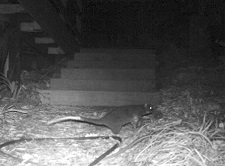
On the basis of previous observations, the critically endangered western ringtail possum (Pseudocheirus occidentalis) has been described as strictly tree-dwelling. Using motion-sensing cameras placed in bushland remnants and residential gardens, we demonstrate that the species uses the ground during its active period at night. To acknowledge that ground use may make the species more susceptible to terrestrial predators than previously thought, we propose that the species should not be described as ‘strictly’ tree-dwelling. Photograph from motion sensing camera set by B. Van Helden.
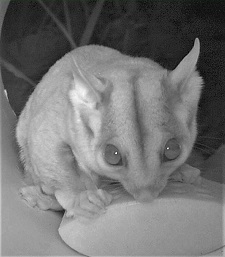
The sugar glider is a tree-dwelling species that is thought to rarely spend time on the ground. However, our baited camera trapping study found evidence of their willingness to spend time on the ground. Our results warrant further investigation of ground use by sugar gliders, particularly in the context of evaluating the threat that introduced foxes and feral dogs may pose. Photograph via selfie trap.
AM19014Albinism in Dasyurus species – a collation of historical and modern records
AM18054A record of movement of a Pilbara leaf-nosed bat between distant diurnal roosts using PIT tags
AM19009Roadkill mitigation is paved with good intentions: a critique of Fox et al. (2019)
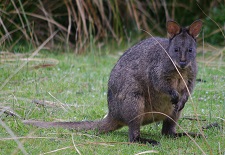
Carcasses of wallabies, possums and other wildlife are a common sight on roads in Tasmanian. A recent trial of a ‘virtual fence’, with flashing lights and artificial sounds, claimed to reduce the number of roadkills along a stretch of road by 50%, but the electronic devices and the roadside trial had many weaknesses. Methods to keep wildlife safe from traffic must be directly relevant to the animals, and thoroughly tested before they are applied on a large scale. Photograph by Graeme Coulson.
AM19031Virtual fence devices – a promising innovation: a response to Coulson and Bender (2019)

Roadkill is a world-wide problem for the persistence of wildlife species, and many mitigation techniques have been advocated. Our paper published in 2018, describing a 3-year trial of virtual fence technology, was critiqued by Coulson and Bender (2019) and here we refute some claims and explain-away others. While our study may not fit into the perfect design mould, we continue to believe that this technology holds great promise. Photograph by DPIPWE, Tasmania.




